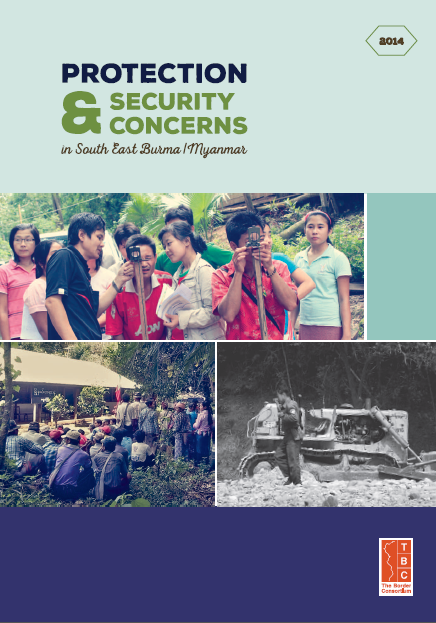Protection and Security Concerns in South East Burma/ Myanmar
By The Border Consortium • November 8, 2014The peace process in Burma/Myanmar1 is at a critical juncture from which it could evolve into a transformative national dialogue or splinter into a divisive charade. While hopes for substantive and inclusive discussion about structural injustice remain, ongoing militarisation and attacks by the national armed forces are undermining the confidence of ethnic stakeholders. This report seeks to highlight the protection and security concerns of conflict-affected communities.
This survey was designed, conducted and analysed by eleven civil society organisations in collaboration with The Border Consortium (TBC). A stratifi ed sampling method was utilised to select 222 out of 665 village tracts spread across 23 townships in South East Myanmar. Community representatives were consulted about militarisation, displacement, security and justice concerns between May and July 2014. Over 2,600 villagers participated in focus group discussions structured around a multiple choice questionnaire and supplemented by personal interviews.
There has been no respite from militarisation since negotiations for preliminary ceasefire agreements began in 2011. The respective troop strength of both the national armed forces and the ethnic armed groups was perceived by local communities as comparable, if not greater, in over 70% of village tracts surveyed. While there has been a reduction in fighting, militarisation is increasingly related to resource extraction and commercial development.
The prevalence of artillery assaults targeting civilians has decreased, but landmine pollution remains a prominent threat in 28% of village tracts surveyed. Intimidation and the threat of violence, primarily from the Tatmadaw and affiliated forces, are similarly widespread. Land confiscation is linked to the consolidation of garrisons, road construction and the establishment of new concessions for mining, logging and commercial agriculture.
TBC estimated in 2012 that there were 400,000 internally displaced persons (IDPs) spread across 36 townships in South East Myanmar. This year’s estimate of 110,000 IDPs is derived from a more precise methodology which is focused on a smaller survey area. The findings suggest that the overall number of internally displaced persons in South East Myanmar has not reduced significantly since the previous assessment.
Over 9,900 formerly displaced persons were identified as having returned into former villages or resettled elsewhere between August 2013 and July 2014. However, 4,200 people were displaced by conflict, abuse or natural hazards during the same period, with the most significant reports of new displacement related to conflict recorded in southern Shan State.
Village leaders and customary law are recognised as the primary mechanism for dealing with serious disputes and violent crimes in 74% of village tracts surveyed. These community justice systems are characterised by a high dependence of mediation, compensation and rehabilitation as well as a lack of capacity to enforce stronger punishment such as prolonged imprisonment. However, concerns were raised about gender bias due to a lack of female participation in dispute resolution and customs relating to property inheritance.
Local priorities for stopping human rights violations and increasing access to justice are documented as demilitarisation and strengthening the agency of local communities. Vital measures for stopping violence and abuse are perceived as the withdrawal of Tatmadaw troops, separation of armed groups, ceasefire monitoring mechanisms and codes of conduct for armed personnel. The emerging Karen Police Force is highlighted as an initiative from ethnic armed groups that could be well placed to enhance community dispute resolution capacities and facilitate referrals for serious crimes to the Myanmar justice system.
Transitional justice concerns have not gained much traction in Myanmar’s formal peace process to date. However, civil society representatives shared a range of opinions about the most appropriate way of dealing with past abuses and promoting reconciliation. While a majority favour pursuing criminal justice to promote accountability, a significant minority suggested offering an amnesty to the perpetrators of abuse so as not to derail the peace process. These debates reflect broader challenges related to the sequencing of peace and justice concerns.
As Myanmar’s peace process stumbles into its fourth year, the prospects for national reconciliation depend more than ever on addressing security and justice concerns. This can be addressed in part by strengthening community protection mechanisms and investing in ethnic policing and judicial capacities at the local level. However, the proposed national dialogue remains essential to address the substantive issues of constitutional reform, security sector reform, land rights and the reintegration of displaced persons.
Download the full report in English here.
အစီရင္ခံစာ ျမန္မာဘာသာကို ဤေနရာတြင္ ေဒါင္းလုပ္ ရယူႏိုင္ပါသည္။
Tags: 2008 Constitution, Burma Army, Burma Government, Ceasefire, Civil Society Organizations, Committee for Internally Displaced Karen People, Displacement, Human Rights Foundation of Monland, IDPs, Karen Environment and Social Action Network, Karen Human Rights Group, Karen National Union, Karen Women Organization, Karenni National Women's Organization, Karenni Social Welfare and Development Centre, Landmines, Legal System, Logging, Mining, Mon Relief and Development Committee, National League for Democracy, National Reconciliation, Peace Process, Security, Shan State Army North-Shan State Progress Party, Shan State Development Foundation, The Border Consortium, United Wa State ArmyThis post is in: Business and Human Rights, Spotlight
Related PostsMyanmar: Release Four “Rohingya Calendar” Political Prisoners
Burma: Rights Priorities for New Government
Myanmar: Scrap or Amend new Law that could Grant Immunity to Former Presidents
Burma Army Moves to Tighten Grip on Power
Sounds of War Taint the Cheers of Election Success










 All posts
All posts